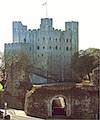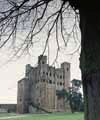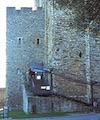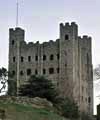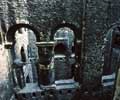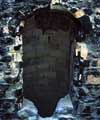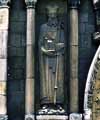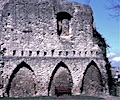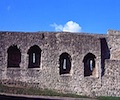Rochester
Kent
From Roman times, Rochester has been of strategic importance, guarding the famous Watling Street route from London to Dover via Canterbury where it crosses the River Medway.
Soon after the Battle of Hastings, 1066, William the Conqueror established a castle here
within the old Roman walled city.
By 1088, the fortifications must have been strong for it to have been used as headquarters for the Duke of Normandy’s rebellion, to unseat his younger brother, King William II (Rufus).
In early June of that year, Bishop Odo, leader of the rebellion, surrendered to King William at Pevensey castle. The King then sent the Bishop ahead with a troop of his men to Rochester to
persuade the rebels to surrender.
One of the chief rebel leaders was Robert de Bellême who refused to surrender to the Bishop, expecting help from the Duke’s fleet to arrive with his army. Outraged at the Bishop’s treachery, Robert de Bellême arrested the Bishop and made him and his royal troop prisoners. By the 18th June, the King and his forces had arrived. Angry at the rebel’s behaviour towards the Bishop, the King immediately laid siege to the city.
After 18 days, and still no relief from the Duke of Normandy, Robert de Bellême and the other rebels decided to surrender. Lack of food and the unusual hot June weather made worse by an infestation of flies and disease, brought about by the King’s siege engines, throwing dead animal carcasses into
the city, made the rebel’s position hopeless.
The following year, the King asked Gundulf, Bishop of Rochester to rebuild the castle in stone. Parts of the curtain wall seem to be of this period. Bearing in mind his earlier work at the Tower of London and possibly Colchester, it seems feasible the castle keep may have been Gundulf’s design. The Keep we se today, is 125 ft in height. Building began in about 1127 and was largely under the
direction of William de Corbeil, archbishop of Canterbury .
During the baron’s war against King John, the castle was held by the rebels. On the 13th October 1215 John laid siege to it and in seven weeks the rebels surrendered to be tortured and mutilated. John had employed miners to burrow underneath the south east tower. The tunnel roof was held up with pit props. His men then herded in forty fat pigs together with brushwood and tar, set it afire and boarded up the tunnel. This resulted in the south east tower and a third of the keep crashing down.
In 1217, John’s son, King Henry III, had the castle repaired, building a drum corner turret instead of the original square turret. By the 14th century, it seems the keep had been devastated by fire. From that time on, no more work was carried out for repairs.
It is now in the care of English Heritage and is open to the public.
English &Welsh Castle Picture Search Results
Your Search returned 13 pictures.
Click on a picture to enlarge and order
